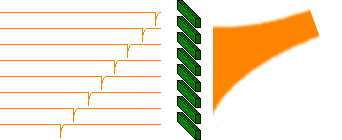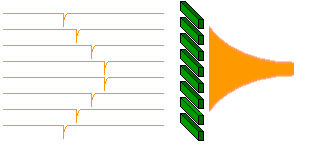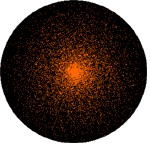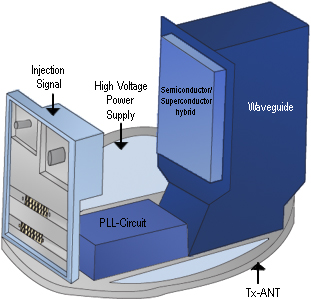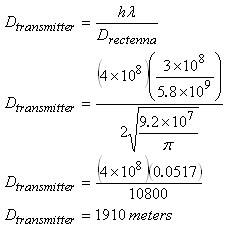|
Mainland High School
Cutting the Cord: ISTF 07-1726 |
||||||||||||||
|
Home
Introduction Components One Two  Product Product
Three Microwave Research W. C. Brown Generators History Phased Arrays Properties Rectennas Semiconductors Solar Satellites Superconductors Moon Research Colonization Helium-3 Fusion Geography Mining Resources Project Assessment Bibliography Glossary Team |
Our Product
Our product is a critical component in the power supply proposal that our team has envisioned. As we examined the massive scope of this proposal which produces electrical energy, converts it, sends it, receives it, and converts it again into useable energy on earth, we concluded that the transmission from the moon was the most critical part of system.
For transmitting, we are going to use a phased array which is a combination of antennas in close proximity. Phased arrays are able to aim and narrow beam effects and become more accurate with more components. Instead of physically moving, they use micro-grids to control phase. The constructive interference produced by the antenna creates a directional beam that is able to be narrowed and widened, electronically, when needed. If a phased array is projecting at a ninety degree angle, it would have the area of high intensity at the middle of the array.
This system will be controlled by computers to account for the orbit of the Moon and the rotation of the Earth. To compensate for the smaller reachable area of the receivers the beam will be narrowed by symetrically changing the phases of each component. This focusing or narrowing of the beam will occur at all times to a lesser extent in order to reduce the sidelobe effect, or electronic noise. The electrical components of our phased array are made up of superconductor/semiconductor hybrids which are used to generate microwaves. These components are protected and kept at an operable temperature by a radiation heat shield. The microwaves are sent through a wave tube and then a cryogenic amplifier which then increases the beam's power. They exit the amplifier and transmit to receiving rectennas located on Earth. In the diagram above:
The array uses a superconductor/semiconductor hybrid to facilitate switching it on and off. The beam can be turned off quickly due to a constant voltage creating the the microwaves. If the voltage is removed, the microwaves cease to be generated. This is an improvement over magnetrons and klystrons that cannot turn off as quickly. The environmental impact on Earth is minimal. Research for the SPS project received clearance by the Environmental Protection Agency for microwave power transmissions limited to an intensity of 23 mW/cm2. At this level of power, the microwaves will not affect birds flying in the path of the beam or wildlife on the ground. The rectenna will prevent the microwaves from affecting plants or crops growing underneath it. According to SPS studies, an "average" 5-gigawatt rectenna would be an ellipse measuring 9 km by 13 km which represents a receiving area of 92 km2 or 22,700 acres. Using their efficiencies and proportions, placing our transmitters on the moon would require a "phased array farm" spanning an area of 2.86 km2, or 706 acres. We believe that this area would be decreased with the phased arrays in our product since they would have more focused central beams with less sidelobe intensities. Use of higher frquencies than those designed for the solar powered satellites would also decrease the required size. Since land on the moon might be easier to procure, the reductions in size might not take place on the moon, but in the size of the rectennas on the earth. The equation to find the diameter for the transmitter was sent to us in email by Dr. Ronald J. Parise, and is given below.1
Once received, the rectenna will convert the microwaves to DC power which can then be used to generate an AC voltage for distribution to the existing power grid in that region. Electronics Manufacturers - Phase-locked loop (PLL) circuit http://www.electronics-manufacturers.com/products/electrical-electronic-components/integrated-circuit-ic/phase-locked-loop-pll/ IEEE Explore - Thermal study of semiconductor-superconductor hybrids http://ieeexplore.ieee.org/xpl/freeabs_all.jsp?arnumber=92483 Imasonic - Phased array principle http://www.imasonic.com/Industry/PAprinciple.php Peregrine Semiconductor - Product Brief http://www.psemi.com/pdf/datasheets/pe42671ds.pdf Research Institute for Sustainable Humanosphere - Compact Microwave Energy Transmitter http://www.rish.kyoto-u.ac.jp/jusps/P03.pdf (pg 4) Science Links Japan - Injection Signal Controlled Active Phased Arrays without Mode Jumps http://sciencelinks.jp/j-east/article/200613/000020061306A0338144.php Space Studies Institute - SSI Sample Slides http://ssi.org/?page_id=14 Dr. Ronald J. Parise 1email correspondence on February 22, 2008 |
